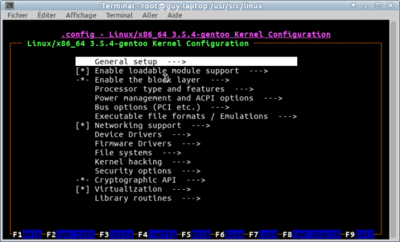Network Interface Configuration
Introduction
One of the most important devices is the network card. One should figure out which driver must be enabled so that networking works properly. This howto will show you how to retrieve information from the virtual file system known as sysfs. We will use different commands to achieve configuration of the network interface card.
Finding the Network Card
Usually we launch the lspci command to discover network devices. Sometimes, this command will miss things. For example, lspci won't inform about a USB device. We then have to use lsusb and the output is not very user-friendly. So let's look at virtual file system. Data is stored in the sys folder or repository. Because we are searching for network interface cards, we have to scan sys/class/net:
root # ls /sys/class/net enp32s0 eth1 lo wlan0
The output shows lo, which is a loopback device. We don't have to deal with this device. Let's go further by getting information about the others:
root # ifconfig -a enp32s0 Lien encap:Ethernet HWaddr 00:26:b9:b2:23:ee UP BROADCAST MULTICAST MTU:1500 Metric:1 RX packets:0 errors:0 dropped:0 overruns:0 frame:0 TX packets:0 errors:0 dropped:0 overruns:0 carrier:0 collisions:0 lg file transmission:1000 RX bytes:0 (0.0 B) TX bytes:0 (0.0 B) eth1 Lien encap:Ethernet HWaddr 00:0e:c6:89:72:03 inet adr:192.168.1.103 Bcast:192.168.1.255 Masque:255.255.255.0 adr inet6: fe80::20e:c6ff:fe89:7203/64 Scope:Lien UP BROADCAST RUNNING MULTICAST MTU:1500 Metric:1 RX packets:9615 errors:0 dropped:1 overruns:0 frame:0 TX packets:9097 errors:0 dropped:0 overruns:0 carrier:0 collisions:0 lg file transmission:1000 RX bytes:7088484 (6.7 MiB) TX bytes:1710731 (1.6 MiB) lo Lien encap:Boucle locale inet adr:127.0.0.1 Masque:255.0.0.0 adr inet6: ::1/128 Scope:Hôte UP LOOPBACK RUNNING MTU:65536 Metric:1 RX packets:0 errors:0 dropped:0 overruns:0 frame:0 TX packets:0 errors:0 dropped:0 overruns:0 carrier:0 collisions:0 lg file transmission:0 RX bytes:0 (0.0 B) TX bytes:0 (0.0 B) wlan0 Lien encap:Ethernet HWaddr 00:16:ea:02:c9:5c inet adr:192.168.1.104 Bcast:192.168.1.255 Masque:255.255.255.0 adr inet6: fe80::216:eaff:fe02:c95c/64 Scope:Lien UP BROADCAST RUNNING MULTICAST MTU:1500 Metric:1 RX packets:4032 errors:0 dropped:5 overruns:0 frame:0 TX packets:19 errors:0 dropped:0 overruns:0 carrier:0 collisions:0 lg file transmission:1000 RX bytes:1360474 (1.2 MiB) TX bytes:2241 (2.1 KiB)
From this list, we can tell that the eth1 device and the wlan0 device are active and working. That can be seen by the following lines:
eth1 Lien encap:Ethernet HWaddr 00:0e:c6:89:72:03
inet adr:192.168.1.103 Bcast:192.168.1.255 Masque:255.255.255.0
wlan0 Lien encap:Ethernet HWaddr 00:16:ea:02:c9:5c
inet adr:192.168.1.104 Bcast:192.168.1.255 Masque:255.255.255.0
Finding the drivers
Now that we have determined that eth1 and wlan0 are the working network devices, we need to compile them into our kernel. Let's find which driver is controlling each device. We will go through different links in the sysfs filesystem.
eth1 driver
root # basename `readlink /sys/class/net/eth1/device/driver/module` smsc75xx
We now know that we have to enable smsc75xx in order to have our wired network interface card working in our kernel.
wlan0 driver
root # basename `readlink /sys/class/net/wlan0/device/driver/module` iwlwifi
We now know that we have to enable iwlwifi in order to have our wireless network interface card working in our kernel.
Configure Kernel
Here we are using thenconfig module of make. We can achieve the same with menuconfig:
root # cd /usr/src/linux root # make nconfig
Press F8 and type in the name of the module. For example : smsc75xx. This will tell you where the network interface configuration files are located in the kernel:
Symbol: USB_NET_SMSC75XX [=y]
Type : tristate
Prompt: SMSC LAN75XX based USB 2.0 gigabit ethernet devices
Location:
-> Device Drivers
-> Network device support (NETDEVICES [=y])
-> USB Network Adapters
-> Multi-purpose USB Networking Framework (USB_USBNET [=y])
Defined at drivers/net/usb/Kconfig:294
Depends on: NETDEVICES [=y] && USB [=y] && NET [=y] && USB_USBNET [=y]
Selects: BITREVERSE [=y] && CRC16 [=y] && CRC32 [=y]
Follow the path indicated by Location:
Under Device drivers:
[*] Network device support --->
USB Network Adapters --->
<*> Multi-purpose USB Networking Framework
<*> SMSC LAN75XX based USB 2.0 gigabit ethernet devices
Credit
Written by: Guy Fontaine (User:Aramis_qc)
